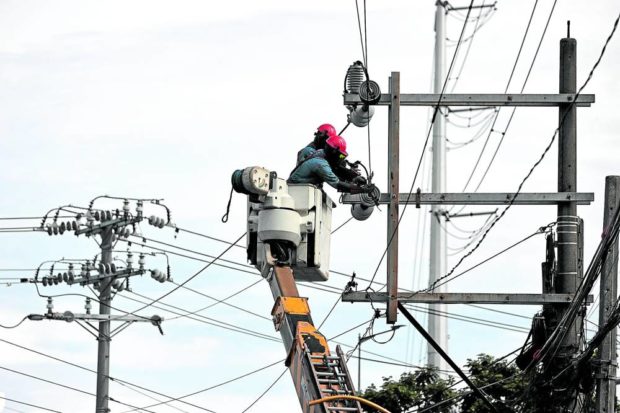Brownouts hit Metro Manila, several Luzon provinces

TOUGH JOB Linemen from Manila Electric Co., or Meralco, repair an electric post in a neighborhood in Valenzuela City on Monday. Several areas in Luzon have been experiencing rotating brownouts since Sunday amid the low electricity supply coming from the island’s power plants. —GRIG C. MONTEGRANDE
Households in Luzon suffered sudden, widespread power interruptions on Monday following a major power line failure or tripping, causing supply shortage in many parts of the island where consumption of electricity has spiked due to the hot weather.
Unscheduled power interruptions started at 1 p.m. in various provinces due to the tripping or shutting down of the Bolo-Masinloc 230-kilovolt Line 2, which stretches from Pangasinan to Zambales, the Department of Energy (DOE) said in a statement.
This subsequently halted supply from the Masinloc Units 1 and 2, which have a combined capacity of 618 megawatts (MW), that affected at least 300,000 customers.
As a result, the National Grid Corp. of the Philippines (NGCP), the private firm operating and developing the government’s power grid, put Luzon on red alert from 1 p.m. to 4 p.m.
It also originally raised a red alert in the Luzon grid from 6 p.m. to 8 p.m., but this was softened to a yellow alert following stabler supply. Available capacity as of this writing was 11,896 MW, while peak demand was 11,093 MW.
Article continues after this advertisementThe reduced power supply generated in Luzon likewise affected electricity sent to the Visayas grid, where a yellow alert was raised from 5 p.m. to 6 p.m.
Article continues after this advertisementPower distributor Manila Electric Co. (Meralco), which covers Metro Manila and nearby provinces, said it implemented manual load dropping, or rotating power interruptions, of up to two hours in parts of its franchise area “as instructed by NGCP and as part of our responsibility to manage the system.”
“We also advised Interruptible Load Program (ILP) participants for possible deloading from the grid to help ease the situation,” Meralco said, referring to its voluntary demand-side program that allows big customers to temporarily disconnect from the grid by using their own generators during red alerts.
The ILP allows the capacity from the grid that was to be supplied to big consumers to be redirected to thousands of households to spare them from longer power interruptions.
At present, Meralco’s total ILP capacity is 616 MW.
According to the company, 321,705 of its customers in Metro Manila and the provinces of Rizal and Cavite were affected by power interruptions triggered by the red alert. Power was fully restored in these areas at 3:45 p.m. on Monday.
Thin supply
“As the situation emanated from a transmission line, the DOE has therefore instructed the NGCP to explain the circumstances within 24 hours,” the DOE said.
According to NGCP, five power plants experienced forced outages while three others were operating on derated capacity, or a decrease in available capacity, triggering the red alert.
This means a total of 1,354 MW of capacity was unavailable to the grid, NGCP added.
A red alert is raised when there is insufficient electricity supply to meet consumer and grid demand, causing power interruptions.
On the other hand, a yellow alert means operating reserve is not enough to meet the transmission grid’s contingency requirements.
Yellow alerts, however, do not necessarily lead to power outages.
The recorded peak demand in the Luzon grid was at 12,468 MW on Monday, NGCP said, noting that available supply was only 12,186 MW, or a deficit of 282 MW.
Following the red alert issuance, the DOE said NGCP also declared a suspension of the wholesale electricity spot market in the Luzon grid to “shield the public from volatile prices that may arise from the unavailability of power plants.”
In January, the DOE projected 15 yellow alerts and no red alerts in the Luzon grid this year.
Energy Undersecretary Rowena Guevara later lowered the yellow alert projection to 10 in March after observing that a number of yellow alerts did not occur in earlier months.
NGCP had warned of thinning power reserves since last year. INQ
RELATED STORY:
Rotational brownouts to hit 1.3 million houses in 2023 — DOE